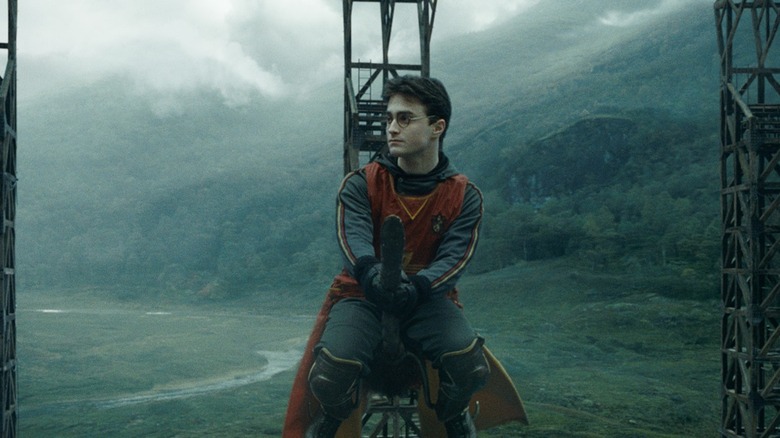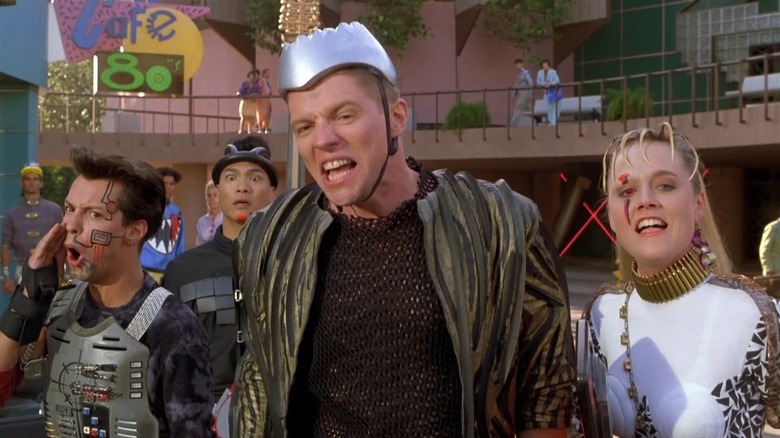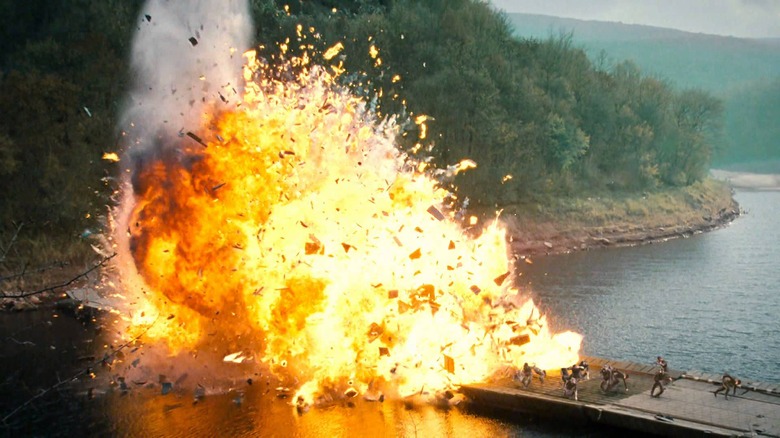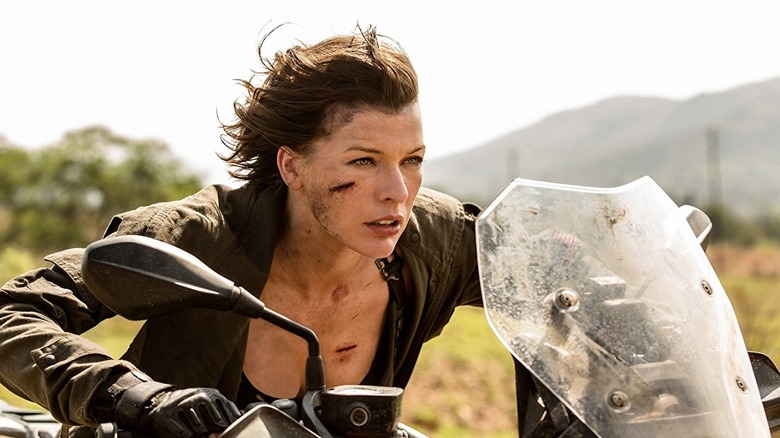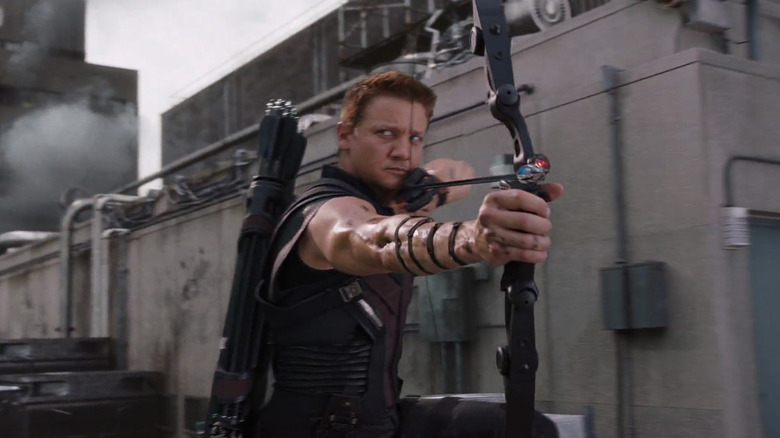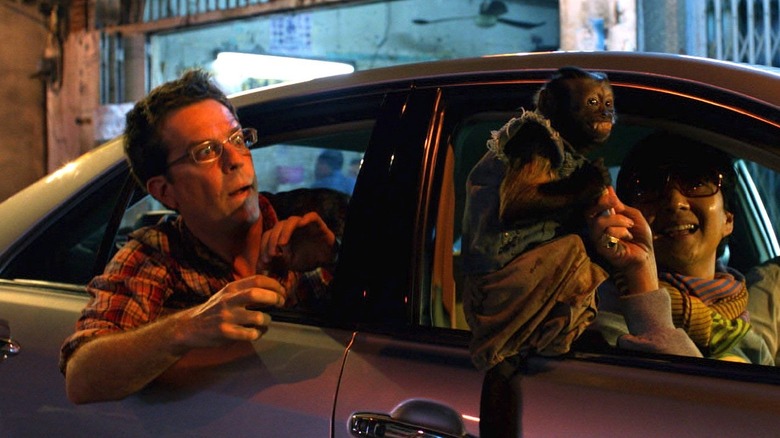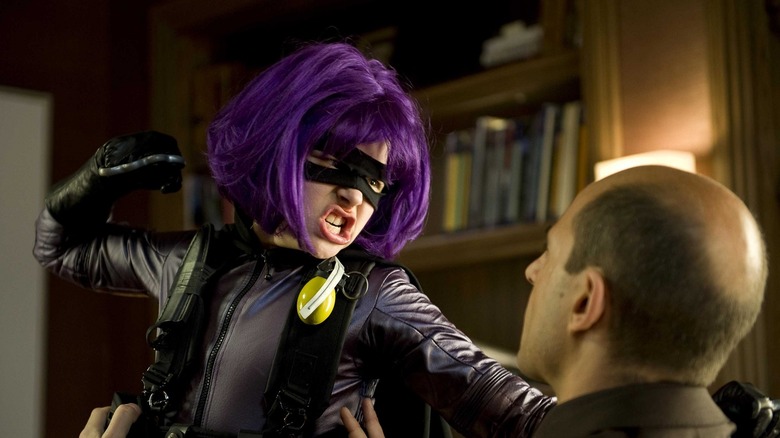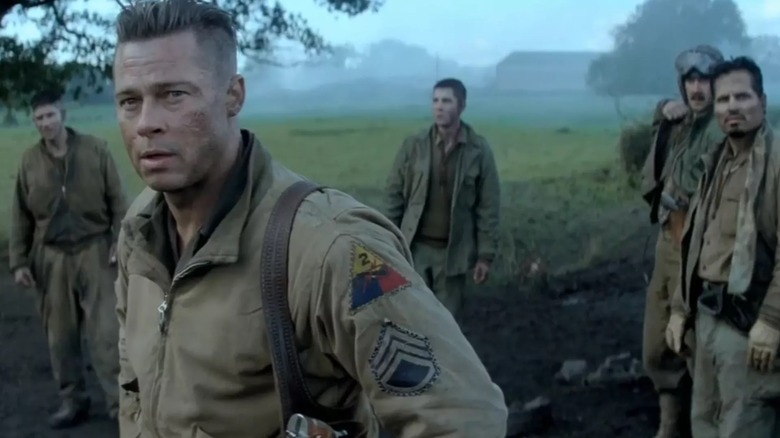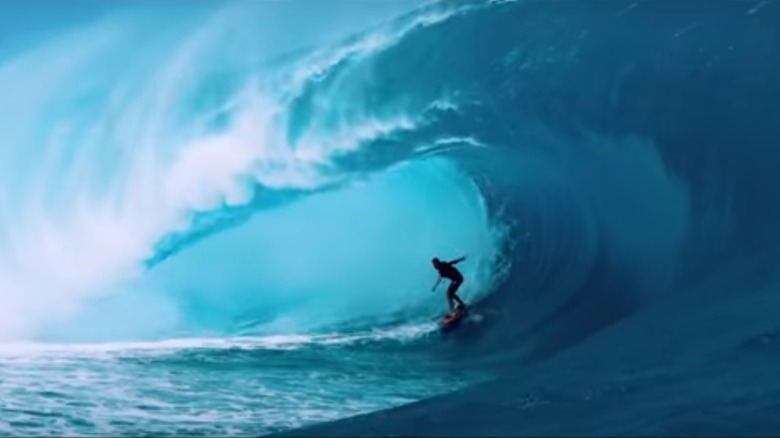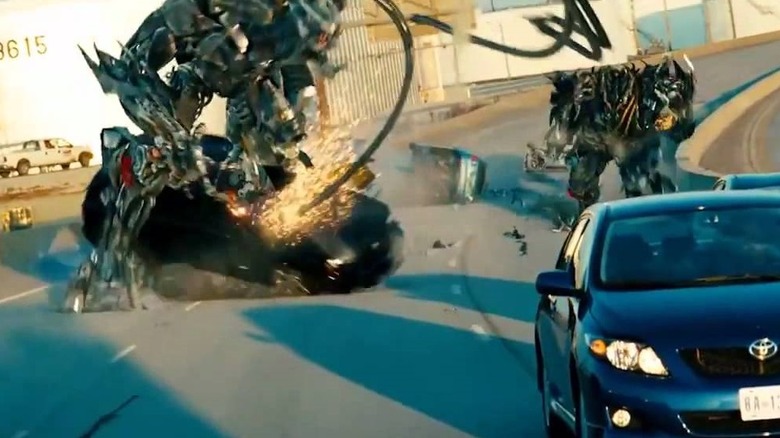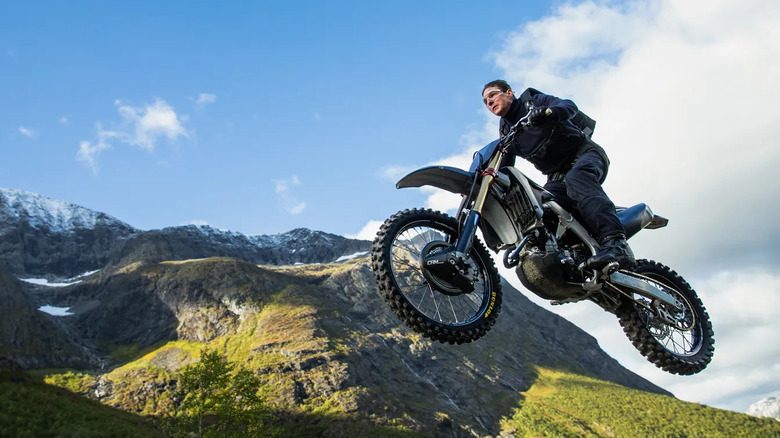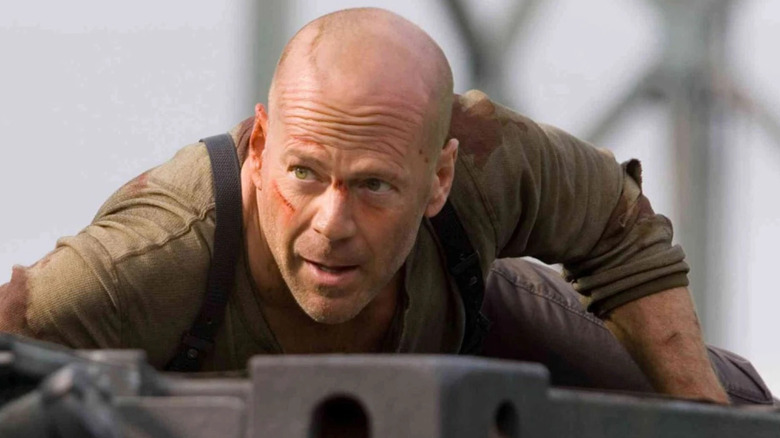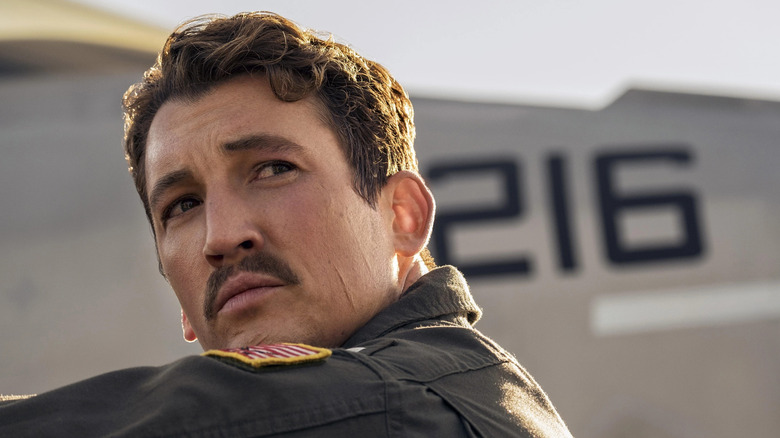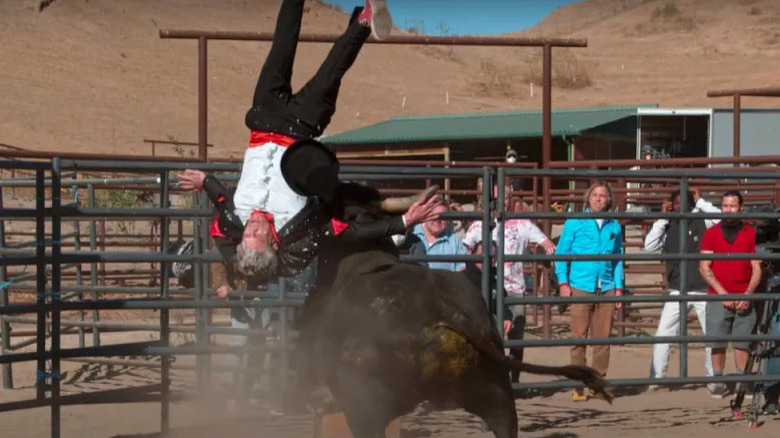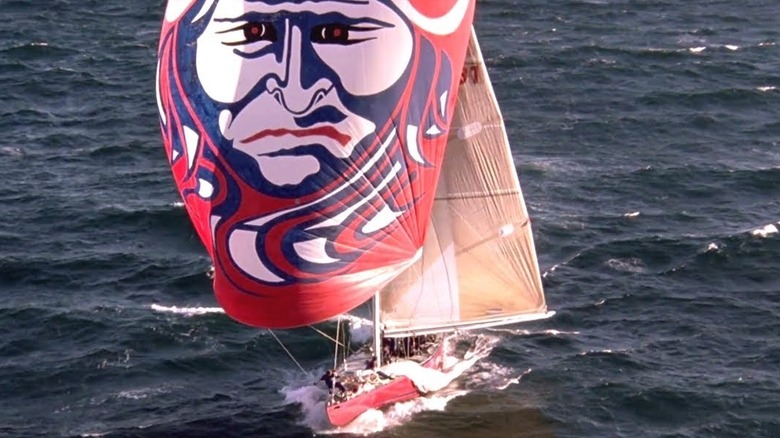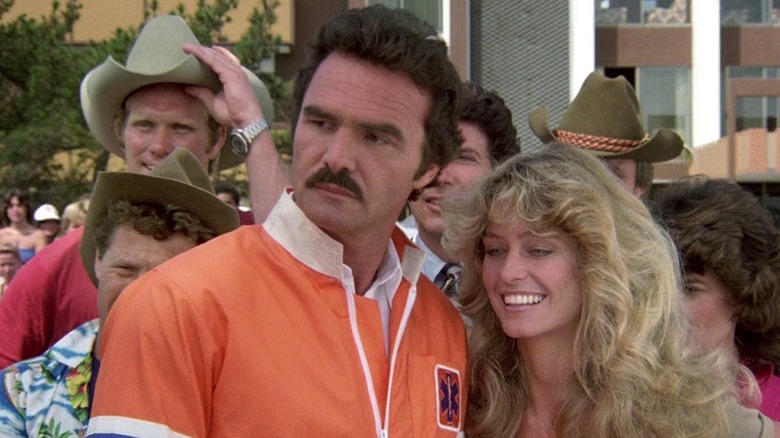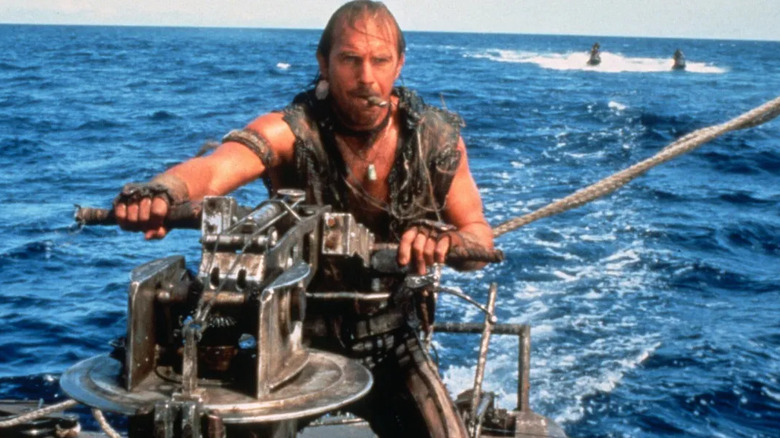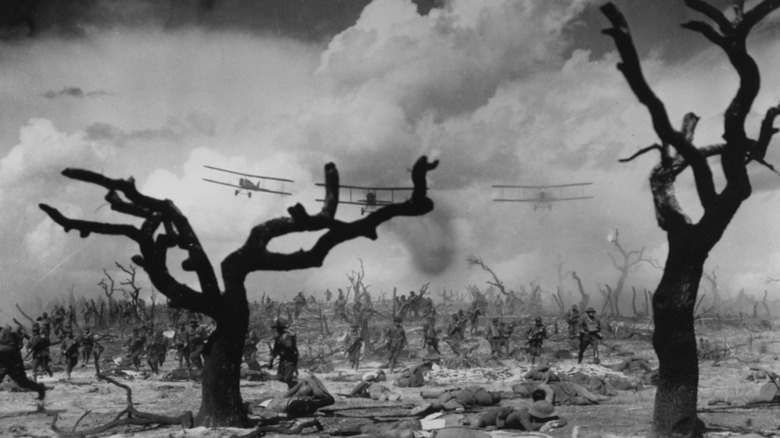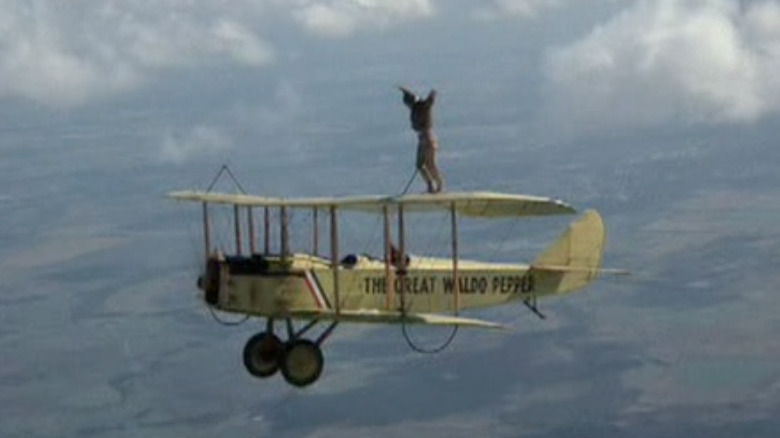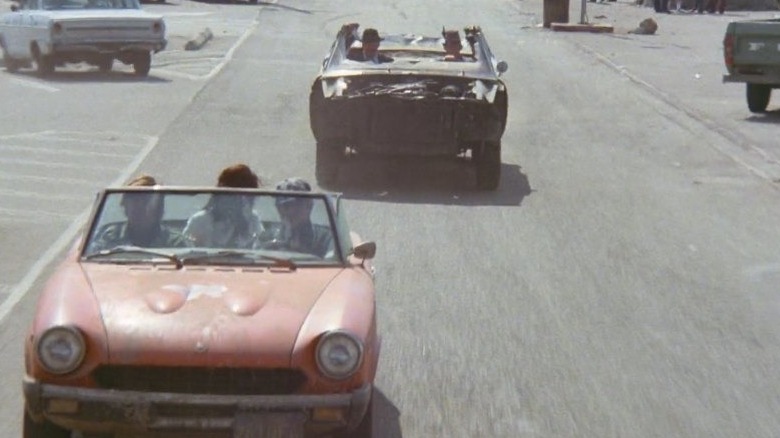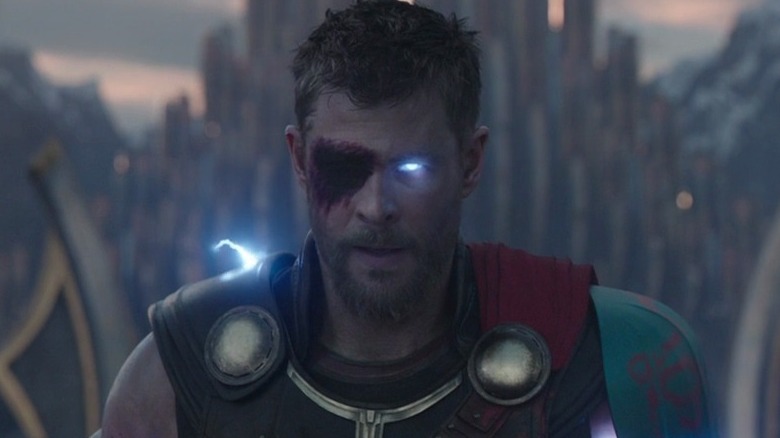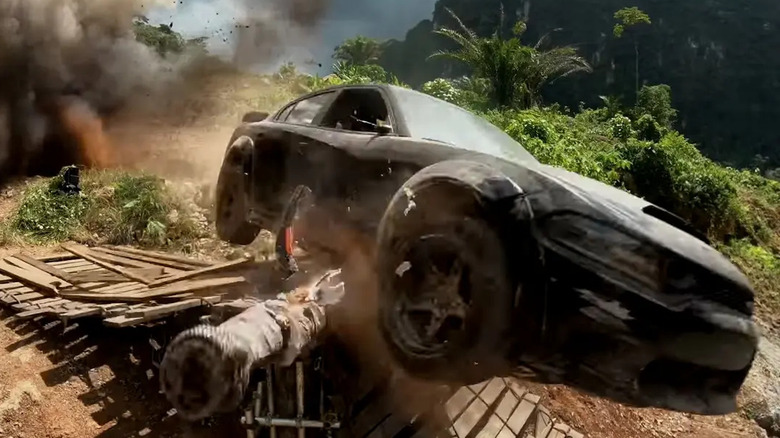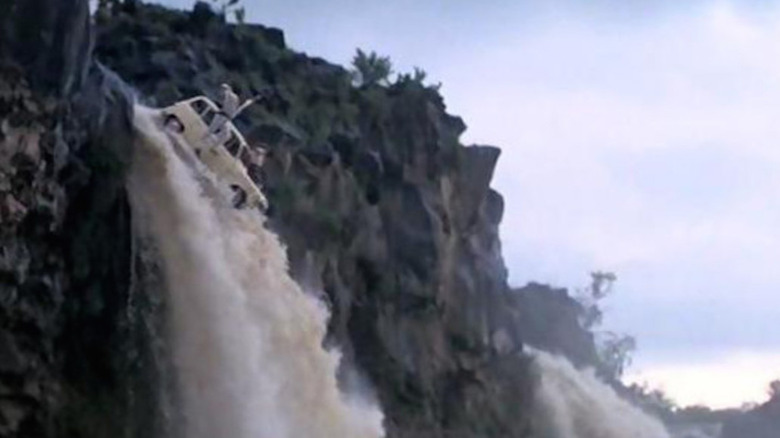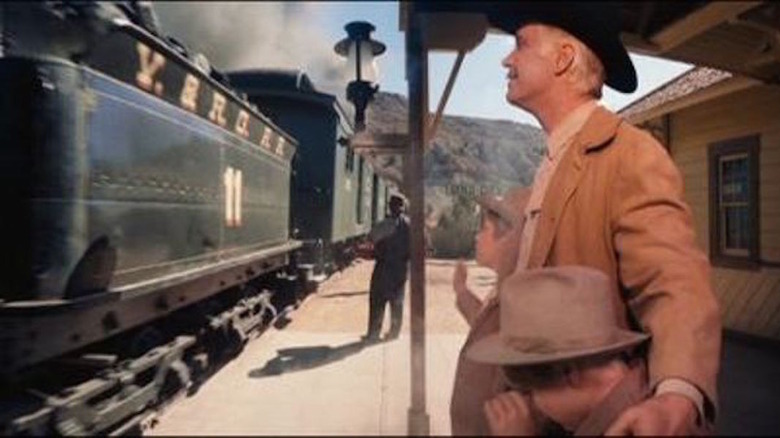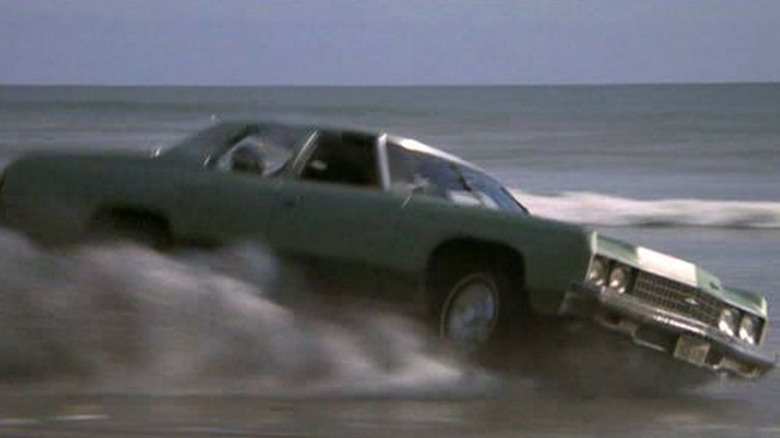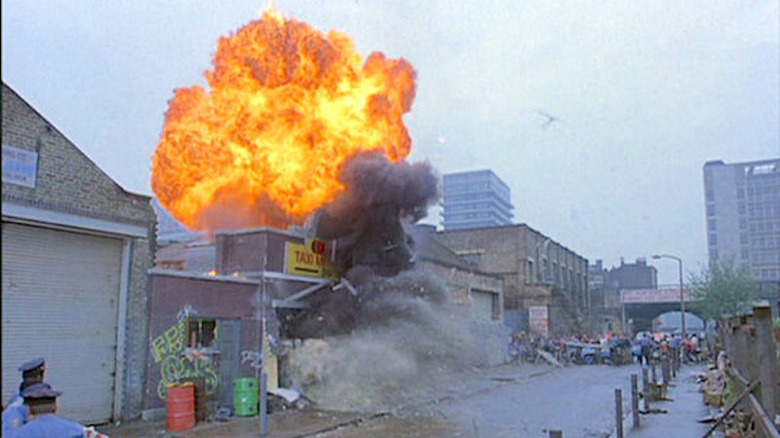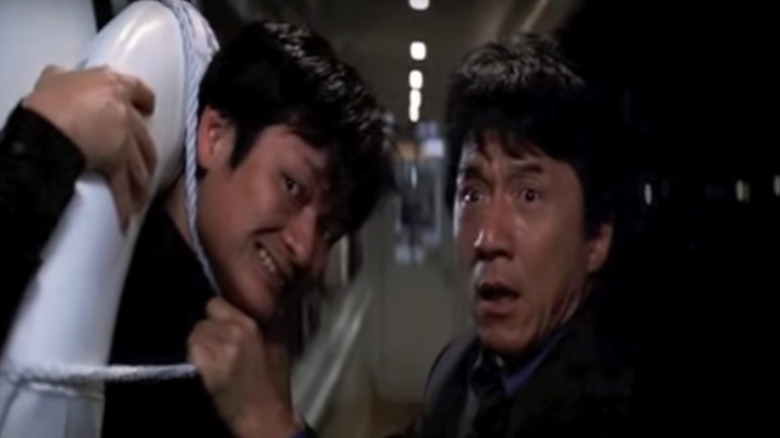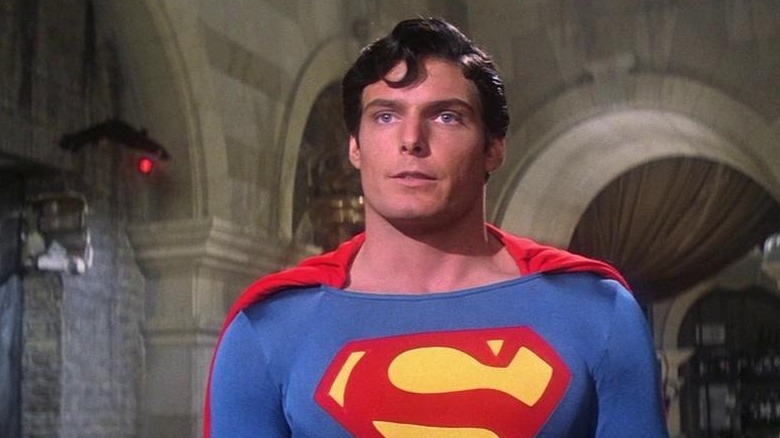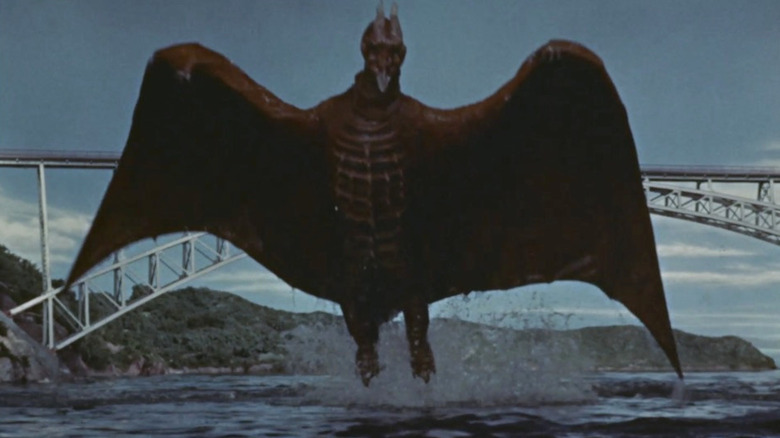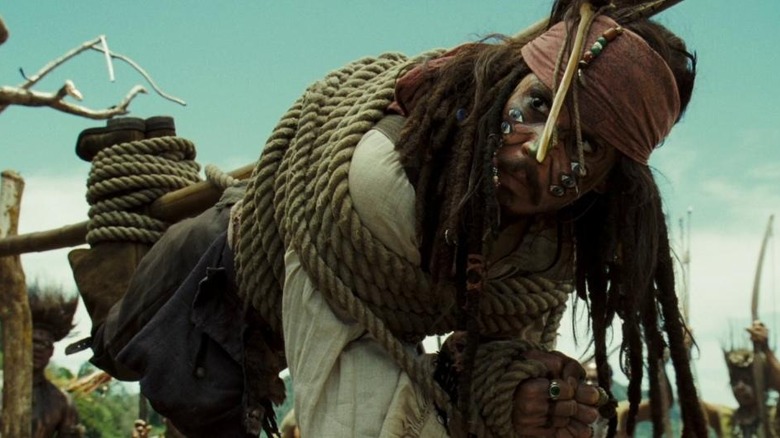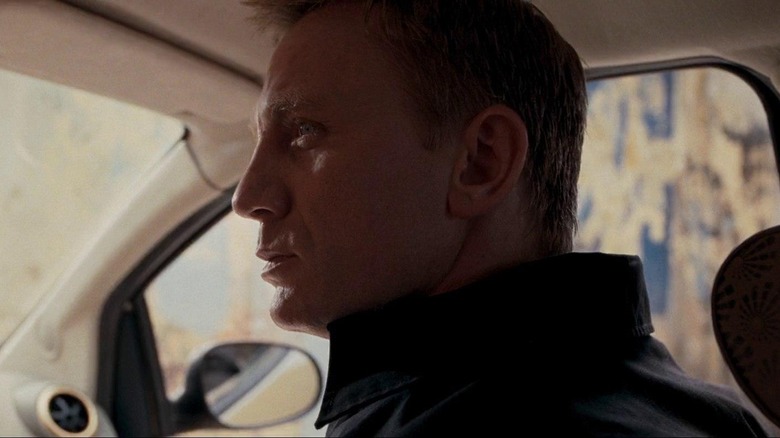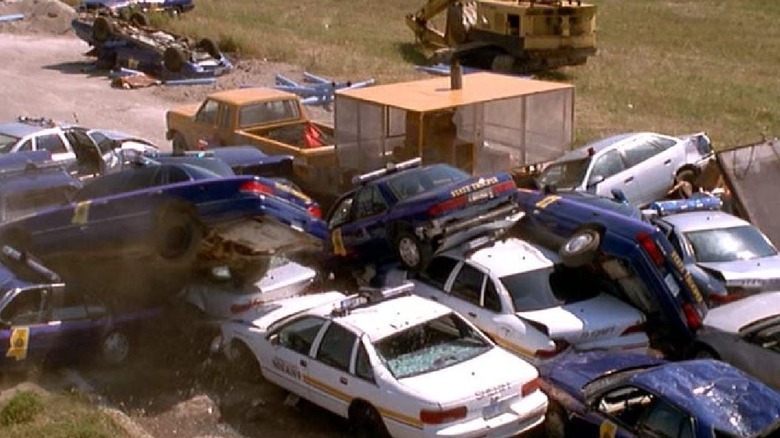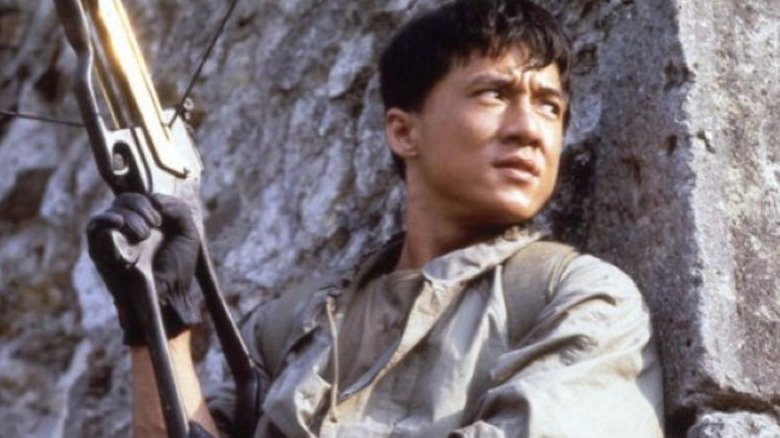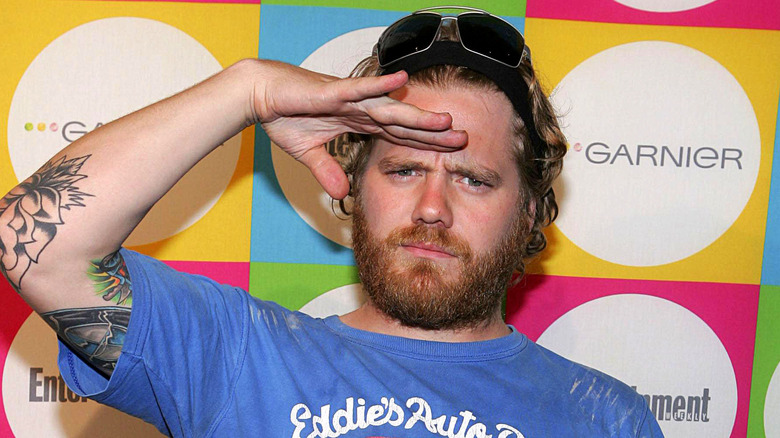Movie Scenes That Almost Killed The Stunt Performer
There are a small number of gutsy Hollywood stars who insist on doing their own stunt work (Tom Cruise has almost been killed multiple times making movies), but most A-listers are happy to hand the really dangerous stuff over to the professionals. Stunt performers are always in demand in Tinseltown, where a pro can expect to earn a reported average of $70,000 a year. That figure can rise very quickly depending on the situation, however, as in the stunt game higher risk equals higher reward.
The biggest fee ever paid for a single stunt went to Dar Robinson, who was given $150,000 to jump off Toronto's CN Tower in place of "Highpoint" star Christopher Plummer back in 1979. He nailed the jump twice without any complications, but not every stunt has a happy ending. Near-brushes with death are an occupational hazard for Hollywood stunt performers — both the ones who stand in for the actors and some of the actors themselves — and these were some of the most hazardous.
Harry Potter and the Deathly Hallows -- Part 1 (2010)
While a lot of CGI work went into bringing Harry Potter's world to life onscreen, Warner Bros. did try to use practical effects whenever possible, especially when it came to broomsticks. That didn't mean the studio was happy to put its star witches and wizards on those broomsticks, however. Stuntman David Holmes doubled for Daniel Radcliffe in a number of scenes, all the way from 2001's "Harry Potter and the Sorcerer's Stone" to 2010's "Harry Potter and the Deathly Hallows — Part 1," on which he suffered a life-changing injury.
Holmes was filming a flying stunt when he was yanked from his broom and slammed into a wall before falling to the ground. The accident broke his neck and left him paralyzed at the age of 25. "I remember slipping in and out of consciousness because of the pain levels," Holmes told The Mirror. "I'd broken a bone before, so recognizing that weird feeling across my whole body from my fingertips right down to my toes, I knew I had really done some damage."
The Mirror's interview also quoted Radcliffe himself, who apparently thinks of Holmes as a friend rather than a colleague. "I would hate for people to just see me and Dave and go, 'Oh, there's Daniel Radcliffe with a person in a wheelchair,'" he reportedly said. "Because I would never, even for a moment, want them to assume that Dave was anything except for an incredibly important person in my life."
Back to the Future Part II (1989)
The hoverboard scene is one of the most memorable moments from "Back to the Future Part II," though for stunt performer Cheryl Wheeler, it brings back painful memories. Wheeler was almost killed shooting the sequence, in which local meathead Griff and his cronies are tossed through the glass window of a clock tower. One stuntwoman had already quit over the scene, and Wheeler became concerned after a handful of last-minute changes were made to the rig, as explained in Caseen Gaines' book "We Don't Need Roads" (excerpted by Gizmodo).
"Are you sure all the marks are right from the other day?" Wheeler asked stunt coordinator Walter Scott. "How are you sure everything is exactly the same?" Scott (a veteran in the stunt industry) accused her of getting cold feet and threatened to put a male stunt performer in her clothes for the scene, but being new to the business and wanting to make an impression, she reluctantly agreed.
Instead of crashing through the sugar glass window, Wheeler collided with a stone pillar and plunged 30 feet onto the concrete below, missing the fall mats entirely. "I was way in the corner, right next to the camera where Cheryl should've been," fellow stunt performer Gary Morgan recalled. "I opened my eyes and I said, 'Where's Cheryl?' and somebody pointed outside. I got up and Cheryl was laying on the concrete and the pool of blood by her head was getting bigger. I thought she was dead."
The Expendables 2 (2012)
Countless henchmen are maimed and killed during the many explosions that take place throughout Sylvester Stallone's "Expendables" films, though one of them actually claimed a life for real. Stuntman Kun Lieu was fatally injured during the filming of a scene involving an inflatable raft for "The Expendables 2" (2012), blown up by a faulty explosion as he drifted on the waters of Bulgaria's Lake Ognyanova. While Lieu's life could not be saved, his partner during the stunt, Nuo Sun, somehow escaped with his.
According to court papers obtained by The Wrap, Sun sustained damage to his "nervous system, neck, head, body [and] arms," which left him in "great mental, physical and nervous pain and suffering." The stunt performer sued Millennium Films and their partners on the grounds of negligence, seeking damages of at least $25,000 as well as the cost of his lengthy hospital treatment and specialist care he would need going forward with his recovery.
The production companies put out a joint statement passing on their condolences and sympathies to the respective families, though Stallone felt the need to address the matter personally while promoting the movie in London. "The stunt team took it very, very hard and shut down for quite a while," the "Rambo" and "Rocky" star told reporters (via the BBC) in the English capital. "It's happened twice before on films I've been on, and it's never easy."
Resident Evil: The Final Chapter (2016)
"Resident Evil" star Milla Jovovich said that it was a "miracle" her double survived an incident that took place on the set of 2016's "The Final Chapter," which left the British stuntwoman in a coma. "A terrible accident rocked our set on Saturday the 5th of September," the actress revealed on Facebook. "My incredibly talented stunt double, Olivia Jackson, collided with a camera crane while performing a motorcycle stunt and it put her in the hospital with severe, multiple injuries."
After she regained consciousness, Jackson also took to Facebook to reveal the horrifying extent of the damage. "Two weeks in a coma, brain bleed, brain swelling, severed main artery in the neck, crushed and degloved face, several broken ribs, paralyzed arm, shattered scapula, broken clavicle, broken humerus, broken radius and ulna, with an open wound and a 7.5 piece of bone missing, amputated thumb, torn fingers, five nerves torn out of the spinal cord," she said. "Not my funnest day on set."
In the end, one of Jackson's arms had to be amputated, with several surgeries still to come. The resilient Brit posted a picture of her upper body to her Instagram feed in January 2017, claiming that her off-centered neck was the most painful part. "I don't mean to moan, but sometimes I just want to crawl out of my own skin and all the pains in it," she added. Jackson sued the film's producers for negligence in 2019, winning her case in 2020.
The Avengers (2012)
Jeremy Fitzgerald has performed stunts in hundreds of films and TV shows over the course of his career, creating an impressive showreel along the way. While his biggest gig might have been doubling for Liam Hemsworth in "The Hunger Games: Mockingjay — Part 2," it was on a movie involving Chris Hemsworth that Fitzgerald almost lost his head — quite literally. He won a Taurus World Stunt Award in the Best High Work category for his contribution to 2011's "Predators," but his high work let him down big time when it came to making 2012's "The Avengers."
The experienced stuntman narrowly escaped getting decapitated after he got tripped up during a 30-foot fall from a building top. Fitzgerald shared a picture of the resulting injury with TMZ and explained how he was supposed to get hit by an arrow (presumably fired by Jeremy Renner's Hawkeye) and then free fall from a ledge. On the way down his foot got caught, and he slammed his head against the building's brick wall, narrowly missing a jagged drain pipe.
In the end, he escaped with his head but was missing a chunk of his scalp. He didn't let that stop him from climbing back up there for more takes, however. "[Jeremy] was fine," a Marvel spokesperson said in reply to TMZ's report. "He slid briefly along the side of the building. He got right back up and did several more takes."
The Hangover Part II (2011)
Australian stuntman Scott McLean was doubling for funnyman Ed Helms in "The Hangover Part II" when he suffered a critical head injury during a car chase, forcing hospital staff to put him in a medically induced coma. "There was an accident involving a truck and a car on the second unit set of 'The Hangover Part II' near Bangkok, Thailand," Warner Bros. said in a statement via The Hollywood Reporter. "An ambulance immediately took the injured stuntman to the local hospital."
The accident took place during the filming of the scene in which Stu (Helms), Phil (Bradley Cooper), Alan (Zach Galifianakis) and Mr. Chow (Ken Jeong) are being chased by Russian gangsters after stealing their monkey. They swerve through traffic as Stu hangs out of the back passenger window attempting to pull the monkey inside, narrowly missing a truck as it comes around the corner in front of them. The drivers involved got their marks wrong, and McLean's head was hit by the truck.
According to a Daily Mail report, McLean (who had previously performed stunts in the "Star Wars" and "Matrix" franchises) was feared dead by his colleagues after the impact, and while he ultimately escaped with his life, his lawyers claim he suffered permanent brain injuries. "There was so much damage," his wife (also a stunt performer) said. "He was a mess. He used to look after me, now it's my turn to look after him for a change."
Kick-Ass 2 (2013)
Chloë Grace Moretz already had 20 credits to her name when she won the part of foul-mouthed 11-year-old assassin Hit-Girl in 2010's "Kick-Ass." "Hit-Girl is that character that really did put me in a different light," Moretz told Rolling Out. "She's the character I would say is my breakout role and put me in the minds of people in this business. It's an amazing role because it's poppy and fun and one of those characters that changed me as an actor, for sure."
None of Moretz's previous roles had been anything near as physically demanding as the Hit-Girl gig, so she put herself through months of intense training and stuntwork to get herself prepared for the part. The stunt coordinators were impressed with how well she adapted and learned the ropes, though they were remiss to let her do the more dangerous scenes despite her willingness. Looking back, she's probably glad the adults talked her down, as one of her stunt doubles suffered a bad injury on set.
"She cracked her head open," Moretz said when asked about the worst thing her double went through while making 2013 sequel "Kick-Ass 2." "They used a hydraulic system and they did it too much and it just pulled her an inch too far and she cracked her head on a bar."
Fury (2014)
Using fake weapons in battle scenes is a lot safer than using real ones, though sometimes they can ruin an otherwise perfect shot — remember Hamish's floppy rubber axe during the emotional final charge in "Braveheart"? That was exactly what David Ayer was trying to avoid in his gritty 2014 World War II flick, "Fury." Brad Pitt stars as Sgt. Don "Wardaddy" Collier alongside an ensemble cast including Logan Lerman, Shia LaBeouf, Jon Bernthal and Michael Peña. The men got to know each other intimately over the course of the shoot, and a large part of that was down to the fistfights they were encouraged to have.
Ayer put the cast through an intensive boot camp and had them partake in heavy sparring as a unique method of bonding before the shoot took place in England, which led to a few flared tempers (LaBeouf admitted that he and Peña butted heads pretty hard at times). While that violence was all staged, there was one moment which wasn't, and it left a stuntman needing an airlift to Oxford's John Radcliffe Hospital. The 35-year-old was stabbed with a bayonet during a battle scene, though the nine-inch blade luckily went straight through his shoulder.
"There has been an accident between two professional stuntmen which happened in a rehearsed action sequence," a spokeswoman for the production confirmed (via the Independent), adding that while it was "obviously very unfortunate," the man in question was "laughing and talking" as he was loaded into the helicopter.
Point Break (2015)
1991's "Point Break" was Academy Award winner Kathryn Bigelow's fourth outing as director, and while the surfer flick wasn't Oscar-worthy in the same way that her 2008 Iraq war thriller "The Hurt Locker" was, it became a cult favorite. A young Keanu Reeves starred as football star-turned-FBI agent Johnny Utah alongside the late Patrick Swayze as Bodhi, the ringleader of the gang of surfers Utah is investigating following a string of bank jobs.
Those roles were filled by Australian actor Luke Bracey and Venezuelan Édgar Ramírez in Ericson Core's 2015 remake, which was torn apart by critics but known for containing some of the most audacious stunts ever attempted. "The danger is off the chart, like, just impossible to even comprehend," BASE jumper Jeb Corliss told Men's Journal while discussing the film's wingsuit scene. "It's probably the most dangerous stunt that has ever been filmed."
It wasn't BASE jumping that led to the worst injury of the shoot, however — it was the killer surf off the coast of Tahiti. Luke Bracey's stunt double Laurie Towner is an experienced big wave surfer who's used to being wiped out in the swell, though he took a bad hit while filming scenes as Utah. "I got myself a broken jaw, some stitches in my lip and eyelid, whiplash to my neck and back and a couple small puncture wounds that went through my neck and into the back of my mouth that apparently just missed an artery," he later recalled on Instagram (via News.com.au).
Transformers: Dark of the Moon (2011)
Extra and background work might be little more than an interesting hobby to most, but for some, it's the first baby steps into an acting career. This was how Gabriela Cedillo felt when she got a job as a passing driver in Michael Bay's third "Transformers" installment, 2011's "Dark of the Moon." Cedillo was asked to take part in a scene involving stunt cars being towed at high speed by flatbed trucks, though when the welding connecting the cars to those trucks failed, she was almost fatally injured.
As she drove her car along a cordoned-off road, the trucks passed her on the opposite side traveling at 50mph. Tragedy struck when one of the brackets attached to a stunt car in tow came loose, smashing through Cedillo's windscreen and hitting her in the head, leaving her with permanent brain damage and paralyzed down one side. She also needed to have her left eye stitched shut, according to details of her lawsuit obtained by the Chicago Tribune.
The stunt (which had an unsuccessful test run just a day before) ended up costing the studios behind the film a small fortune. Cedillo was eventually awarded $18.5 million in damages, though her legal team claimed that DreamWorks and Paramount Pictures did everything they could to avoid paying out. "I think they were well aware of what was going on out there," The Guardian quoted Cedillo's lawyer Todd Smith as saying.
Mission: Impossible - Dead Reckoning Part One (2023)
Every "Mission: Impossible" feature has one stunt sequence that seems to put franchise star Tom Cruise's life in danger — such as his ascent up the Burj Khalifa, the world's tallest building, in "Ghost Protocol" — and in "Dead Reckoning," Cruise rides a motorcycle off a cliff and parachutes away as the bike plunges into oblivion. Like all of the stunts in the "Mission: Impossible" films, the motorcycle gag was meticulously planned through hundreds of hours of skydiving and jump training. And as Cruise told Entertainment Tonight Canada, all the preparation came in handy when the stunt didn't go exactly as hoped.
Cruise said that he discovered that the stunt had gone awry at the worst possible time — right after he opened his parachute. "You can see when I opened, I was in the wrong position," he said. "And the parachute turned into the side of the mountain." Had the parachute pulled him into the mountain, the impact might have been fatal. "I was very close," he added. Luckily, Cruise was able to correct his course at the last second. "And that was day one [of production]," he said.
Live Free or Die Hard (2007)
As Bruce Willis's stunt double for nearly a decade, Larry Rippenkroeger faced elaborate stunt set pieces on a regular basis. One, however, got the better of him in 2007: while working on a night shoot during filming for "Live Free or Die Hard," Rippenkroeger descended a ladder on a fire escape in downtown Los Angeles and either lost his footing or missed a handhold, as he told the Los Angeles Times. He fell head first three stories and though he was able to break his fall, he suffered serious injuries. "I had compound fractures of both wrists, smashed the right side of my face, fractured my skull on the back of my head, [got a] couple of broken ribs, and a punctured lung," he recalled.
His injuries required a series of surgeries, including the insertion of titanium plates in his face and wrists. They were funded in part with a grant by the Taurus World Stunt Awards Foundation, which provides financial assistance to members of the World Stunt Academy who undergo serious injuries. Rippenkroeger not only recovered but also returned to work on numerous films, including "Guardians of the Galaxy Vol. 2" and "Bird Box," while also earning Screen Actors Guild nominations for Outstanding Performance by a Stunt Ensemble for "Iron Man" and "Breaking Bad."
Top Gun: Maverick (2022)
Tom Cruise demanded near-total authenticity for the flying scenes in "Top Gun: Maverick," so his co-stars underwent rigorous three-month training sessions to get used to the hair-raising aerial acrobatics of military jet fighters. For Miles Teller, who played Bradley "Rooster" Bradshaw in the film, the experience was both exhilarating and terrifying — especially one sequence that had him convinced he was going to die.
Teller, who like his fellow actors sat behind pilots in real fighters for "Maverick," said that the scene in question involved a maneuver called a "max pull-up." "You're heading down and at the last second, you yank up, and it's really tough for the pilot," he told LADBible. Pilots practice max pull-ups all the time, but it was an all-new experience for Teller, and at the time, one that he thought would be his last. "I completely stopped acting," he said. "I looked at the ground and thought this wasn't going to end well for me."
Fortunately, Teller walked away from the stunt not only alive but also without vomiting — an achievement that many of his co-stars couldn't claim. "I think that when there's that much adrenaline and a healthy bit of fear, I was able to hold it down," he recalled. "I guess that's a secret skill I have."
Jackass Forever
The injuries that "Jackass" star Johnny Knoxville has endured in the pursuit of a laugh are so extensive — he's torn his urethra, herniated multiple discs, and shattered his eye socket — that it's impossible to conceive that one was worse than the others. But Knoxville says the stunt involving the bull in "Jackass Forever" had some of the most devastating long-term effects.
On paper, Knoxville was going to perform a magic trick in front of a bull before it hit him, and that's exactly what happens in the finished film. But the hit is far more brutal than Knoxville or the filmmakers expect: he does one and a half complete rotations in the air before landing unconscious in the dirt. He's immediately hospitalized, where doctors find that he has a concussion as well as a broken wrist and ribs. But as Knoxville later stated, the injuries were far more extensive.
Knoxville also experienced a brain hemorrhage that left him with not only cognitive problems but also depression, both of which required a year of recovery and treatment. The injuries forced Knoxville to rethink his participation in future "Jackass" efforts, if any. "I can do little stunts where if I, you know, break a hand or an ankle or whatever, no one cares about that," he told ABC News. "I just can't — no more concussions for me."
Wind (1992)
The 1992 movie "Wind," a drama about the 1987 America's Cup yacht races, is probably best remembered for a gruesome accident that occurred during filming. Directed by Carroll Ballard ("The Black Stallion") and produced by Francis Ford Coppola, "Wind" spared no expense to depict the excitement and breakneck thrills of competitive sailing, including location shooting in Utah and Western Australia. The accident took place in the waters off the southwestern coast of the latter location in March 1991.
The accident happened during filming for a sequence involving multiple 12-meter yachts and chase boats, which are smaller boats used by yacht owners and crews for additional transportation and storage. Two of the yachts collided with a stationary chase boat, sending stunt man Trevor Hellier and stunt coordinator Christopher Anderson overboard.
Both men were hospitalized with serious injuries: Hellier suffered chest and abdominal trauma, while Anderson fractured his pelvis and ruptured an artery in his right leg that later required partial amputation. Despite this traumatic setback, Anderson has continued to work as a stunt performer and coordinator — most recently on "Mortal Kombat" — as well as an actor and second unit director.
The Cannonball Run (1981)
"Cannonball Run" may be remembered for its all-star cast playing broadly for low-hanging laughs, but the 1981 film also has another legacy: one of its racing sequences ended the career of stunt performer Heidi von Beltz. Just 24 at the time of filming in 1981, von Beltz was invited by her fiancée, stunt coordinator Bobby Bass, to serve as Farrah Fawcett's stunt double in the film. One sequence required von Beltz to ride shotgun in an Aston Martin as it drove through a pack of oncoming cars. Though Bass assured von Beltz and director Hal Needham that the car was able to handle the stunt, it wasn't — it lacked seatbelts, for one — and slammed into the cars, hurling von Beltz against the windshield and leaving her paralyzed from the neck down.
Von Beltz later won an award of $4.6 million as part of a wrongful injury lawsuit; more importantly, her accident spurred the film industry to make seat belts mandatory in all stunt vehicles. Though doctors told her that she would live only a few months after the crash, von Beltz beat the odds for more than 35 years until her death in 2015 at the age of 59.
Waterworld (1995)
Enough words have been written about the behind-the-scenes disasters on "Waterworld" to fill the remains of the "Exxon Valdez," which in the film serves as the lair of villain Dennis Hopper. These include stars Jeanne Tripplehorn and Tina Majorino being thrown from their sailboat and requiring rescue by divers, as well as star-producer Kevin Costner strapped 40 feet in the air to a sailboat mast as an ocean storm blew in, leaving him unreachable and in danger for a half hour.
Often excluded from the litany of mishaps on "Waterworld" is stunt performer Norman Howell's brush with death. Howell, who served as Costner's stunt double, surfaced too quickly during a deep sea dive sequence and experienced an embolism — an air bubble that escapes from the lungs and enters blood vessels, which can have lethal consequences. Costner flew Howell to a hospital in Honolulu, where he recovered after spending time in a decompression chamber. He returned to work a few days later, and remains active as an Emmy- and Screen Actors Guild Award-winning stunt performer on "Mayans MC," among other projects, as well as an actor and second unit director.
Wings (1927)
A decorated fighter pilot during World War I, Dick Grace returned home to the United States and found an outlet for his aviation skills in barnstorming, in which pilots toured the country performing death-defying stunts in planes. His abilities caught the eye of silent movie Western hero Tom Mix, who asked him to crash a plane into the site of a barn for an upcoming film. Grace accomplished it without a scratch and went on to become something of an expert in the art of crashing planes on film.
One assignment nearly cost him his life: Paramount's "Wings," which became the first film to win a Best Picture Oscar, tapped Grace to create several spectacular crashes for its story of combat pilots in World War I. One elaborate setup required him to fly his plane into the ground at a high speed, but upon impact, the restraining straps broke and flung Grace into the instrument panel. The accident left four of his vertebrae crushed and required a 17-week stay in the hospital. Grace not only recovered but also became a published author and even served as a combat pilot at the age of 46 in World War II. He later operated an airline service until his death in 1965.
The Great Waldo Pepper (1975)
World War I combat pilot Frank Tallman parlayed his love and talent for flying into a career as a stunt pilot, flying supervisor, and supplier of vintage and historic airplanes for films and television. Among his credits as a stunt flyer were "It's a Mad, Mad, Mad, Mad World," "Catch-22," and "The Great Waldo Pepper," a 1975 action-drama with Robert Redford as a World War I vet turned stunt pilot.
Tallman crashed his stunt plane three times during the making of the film — not surprising, given its sheer number of complicated aerial stunts. Two of the crashes were planned and he walked away from them unscathed, but the third, which occurred during a routine landing, was unplanned and sent Tallman into the side of a hill. He suffered two cracked vertebrae, a broken rib, and a lacerated scalp that required 58 stitches. Two weeks later, Tallman was back to work and overseeing flying sequences for television while also participating in air shows. Three years later, the 58-year-old Tallman died while flying in bad weather from California to Phoenix, Arizona; his plane crashed into the Santa Ana Mountains on April 15, 1978.
No Deposit, No Return (1976)
Like many stuntmen, Dale Van Sickel parlayed athletic success into steady work as a stunt performer in Hollywood films and on television. A star player in football, basketball, and baseball at the University of Florida in the late 1920s, Van Sickel headed west after graduation with the intention of becoming an actor. But he found more consistent and substantial work as a stuntman in everything from "Gone with the Wind" to serials and B-Westerns. In the 1950s, he added television to his resume, most notably on "The Adventures of Superman," for which he served as star George Reeves' double. He capped his long career with major projects like "Duel" (as Dennis Weaver's driving double) and a stint as the first president of the Stuntmen's Association of Motion Pictures.
Van Sickel also worked for Walt Disney Studios on several occasions, including 1976's "No Deposit, No Return." While filming a vehicular stunt, Van Sickel's car skidded and crashed into a structure, causing his head to strike the windshield. He suffered brain damage that led to a slow decline and his death in 1977.
Thor: Ragnarok (2017) and Green Lantern (2011)
Every stunt performer has their share of anecdotes about injuries endured while filming, but Bobby Holland Hanton seems to have more than his share of behind-the-scenes horror stories. Hanton, who has served as stunt double for some of Hollywood's biggest leading men — Tom Cruise, Chris Evans, Ryan Reynolds, and for more than a decade, Chris Hemsworth – detailed to Daily Mail Australia a litany of the gruesome wear and tear his body endured while making the "Thor" films, "Mission: Impossible — Fallout," and "Green Lantern."
Hanton ruptured multiple spinal discs while making "Green Lantern" and "Thor: Ragnarok," which left him with a neurological condition called drop foot or foot drop syndrome, which causes paralysis in certain foot muscles that makes it difficult to lift or move the front of the foot. "I've also snapped my groin clean off the bone and blew my shoulder out," said Hanton. "And during 'Mission: Impossible,' I popped my rib out on set. It's fair to say that I've had my fair share of injuries," he recalled.
F9: The Fast Saga (2021)
Stunt performer Joe Watts suffered what he later described as "life-changing" injuries after falling more than 20 feet while rehearsing a stunt for "F9: The Fast Saga" in 2019. The stunt required Watts to be thrown from a balcony, but a safety wire that would have broken Watts' fall malfunctioned, causing Watts to instead land on the soundstage's concrete floor. His injuries, which included a skull fracture and brain trauma, left him in a coma for five days. Watts later had to undergo extensive therapy to treat cognitive and physical problems caused by his fall.
Watts sued FF9 Pictures Limited, the film's production company and a subsidiary of Universal Pictures, for more than $1.2 million in 2022. The legal filings noted that Watts would not be able to return to stunt work and sought damages for loss of income; the company accepted the blame for the accident in 2023. However, the company did not reveal what it would pay Watts, indicating instead that it would utilize "expert evidence" to determine an appropriate amount.
Romancing the Stone (1984)
For Robert Zemeckis's "Romancing the Stone," stuntmen Terry Leonard and Vince Dedrick Jr. doubled for stars Michael Douglas and Kathleen Turner for a scene in which their jeep is swept down a river and over a 70-foot waterfall. Waiting at the bottom of the falls was the "impact zone" — a raging whirlpool that would absorb the jeep but most likely spell instant death for the stuntmen if they landed in it. Unfortunately, that was exactly where Leonard was headed when the stunt went wrong.
A retaining cable that was supposed to catch the jeep and allow both performers to leap free of the car and into the water failed to do its job, sending both men and the vehicle into the impact zone. "And while it was happening, I knew I was dying, that this was the end of my life," said Leonard in an interview with Sports Illustrated. Thankfully, Leonard was able to not only break free of the whirlpool but also get out of the water thanks to a group of fishermen. Survival wasn't the only thing on Leonard's mind at the time: "I remember hoping they got the shot all right," Leonard told SI.
How the West Was Won (1962)
Stuntman Bob Morgan stood 6'4", which made him ideal as a stunt double for tall, broad-shouldered Western movie heroes like John Wayne. Morgan worked extensively throughout the 1950s on historical epics like "Spartacus" and Wayne's "The Alamo" before tackling one of the biggest movies of the period. "How the West Was Won" featured an all-star cast led by Wayne, Henry Fonda, and James Stewart, while no less than three directors (including John Ford) were needed to tell its story of the taming of the American West. For cast and crew, it was a major success, netting eight Oscar nominations (and earning three) and pulling in almost $50 million – a huge windfall in 1962 box office numbers.
For Morgan, "How the West Was Won" marked the end of his stunt career. Morgan was doubling for George Peppard in a shootout sequence between a marshal and a gang of train robbers. Accounts vary as to what exactly happened, but logs stacked on the flat car that carried Morgan became loose and either crushed him or knocked him under the train. Though he was able to free himself, Morgan lost a leg in the process, which made his brand of athletic stunt work impossible. He did, however, find work as a character actor in films and in television until the mid-1980s; Morgan died at the age of 82 on February 22, 1999.
McQ (1974)
Before he directed "Smokey and the Bandit," won an honorary Oscar in 2013, and inspired the character of Cliff Booth in "Once Upon a Time ... in Hollywood," Hal Needham was a fearless stuntman in films and on television series like "Star Trek." Needham was also an innovator who introduced airbags to break stuntmen's falls. He took his fair share of hits as well: he told the crowd at the 2013 Academy Awards that he had broken 56 bones, including his back (twice), over the course of his stunt career.
Recounting some of his most dangerous stunts for Stunts Unlimited, the stunt organization he co-founded in 1970, Needham singled out a car rollover for the 1974 movie "McQ" with John Wayne. For the gag, he and stunt coordinator Ronnie Rondell built a cannon loaded with a three-foot telephone pole and an explosive charge and attached it to the car beneath the driver's seat. When the charge was fired, the pole would shoot down and launch the car into a roll.
Finding that one charge would only lift the car a few inches, Needham and the crew loaded four charges into the cannon and Needham took off. The resulting blast sent the car 30 feet into the air before it landed on its roof; Needham awoke in the hospital to find he had six broken ribs, a punctured lung, a broken back, and three missing teeth.
Death Wish 3 (1985)
British stuntman Rocky Taylor began his career in 1962 with "Dr. No" — the first of many assignments for the James Bond franchise — and continued to perform stunts as late as 2022 in "The Batman." Along the way, he lent his expertise to such films as "Superman" and "Raiders of the Lost Ark," and set a Guinness World Record in 2011 for smashing a car through a 257-foot pane of breakaway glass. Taylor also suffered a horrific injury in 1985 while leaping from a burning building on the set of the movie "Death Wish 3."
The stunt required Taylor to leap out of the window of a 17-foot-tall building while flames raged around him. A miscalculation caused an explosion that not only set Taylor ablaze but also sent him plummeting to the pavement below. He was hospitalized with a broken back and pelvis and burns to both his face and hands, but recovered and returned to stunt work in films like "Avengers: Age of Ultron" and both parts of "Harry Potter and the Deathly Hallows." In 2011, he recreated the stunt that almost killed him by leaping from a flaming building in London; this time, he walked away from the gag. "It was something I had to do, and I'm glad to have finally done it again and got it out of my system," he told The Daily Mail.
Rush Hour 2 (2001)
A busy stunt and fight coordinator for Hollywood features and television series like "Shang-Chi and the Legend of the Ten Rings," "True Blood," and "Twilight," Andy Cheng began his career as a member of Jackie Chan's legendary stunt team. Cheng served as both Chan's stunt double and as an on-screen combatant in films like "Rush Hour" and its sequel. The latter film gave Chan the opportunity to repay Cheng for his service by saving his life during a stunt sequence that went awry.
One of the film's fight sequences required Chan to kick Cheng and another stuntman off a moving boat. The stunt initially went as planned, with both performers hitting the water — but only one of them emerged from the water. Cheng was trapped under the boat and struggling to not only get to the surface but also avoid the boat's propellers. As his air began to run out, Cheng felt a hand yank him out of the water — it was Chan himself, who reached under the boat to rescue his team member.
"I felt like a god grabbed me and pulled me out of the water," Cheng told ABC News. "A moment later, I would have been dead. He gave me [a] second life."
Superman (1978)
When veteran stunt performers get together, what do they talk about? If the Mirror's 2021 conversation with longtime British stuntmen Greg Powell and Jim Dowdall is any indication, the conversation turns to the movies they made and the injuries they incurred while working on them. Powell and Dowdall both began their careers in the late 1960s and early '70s (and were still active as of 2022), and over the past five decades worked on some of the movie industry's biggest titles, including multiple entries in the "Star Wars," James Bond, and "Harry Potter" franchises.
They've both taken their lumps over the course of their careers, but only once did Dowdall come close to death. While filming "Superman" in 1978, Dowdall was supposed to leap from a trampoline and tackle another stunt performer. "I didn't get quite far enough and my head hit the ground at his feet," he recalled. "I fractured three vertebrae in my neck." But when asked if he'd risk it all again, Dowdall didn't hesitate to answer. "I've met the most amazing people," he said. "And I've had the most incredible fun."
Rodan (1956)
If there was a Hall of Fame for the actors who wore monster suits in movies (and there really should be one), Japanese actor Haruo Nakajima would be a star attraction. From 1954 to 1972, Nakajima destroyed Tokyo and other Japanese cities as the "suitmation" actor for Godzilla, Rodan, the larval form of Mothra, and many other kaiju for Toho Company's iconic fantasy-science fiction films.
Portraying the monsters required more than just stomping on Eiji Tsuburaya's elaborate miniature sets. The original Godzilla costume weighed more than 200 pounds and reached internal temperatures of 140 degrees; while subsequent suits were lighter, they all offered Nakajima limited visibility (he peered through holes in the neck) and offered little protection from explosives or flooding during scenes in Toho's water tank.
Nakajima took his lumps as Godzilla but faced death while playing another famous monster. In an interview for SciFi Japan, Nakajima recalled being lifted by wires to the rafters of Toho's set while playing the flying monster Rodan. Suddenly, the wheel pulley raising one of the wires broke, causing the Rodan suit to go into a spin; the other wires soon broke and Nakajima plunged 20 feet to the studio floor. "But I fell into the pool on the set which was full of water," Nakajima recalled. "That saved my life. Winged suits are definitely hard!"
Pirates of the Caribbean: Dead Man's Chest (2006)
Veteran stunt performer Tony Angelotti's credits include "The Amazing Spider-Man" and repeat engagements as Johnny Depp's stunt double on three of the "Pirates of the Caribbean" films. The Disney productions required Angelotti to pull off some astonishing stunts, but one set piece in "Dead Man's Chest" not only ended his stunt career but also nearly ended his life.
In the scene, Jack Sparrow falls from a height while wrapped in a rope, which unravels and holds him aloft by one leg. The "yo-yo" stunt required a descender — a wire rig that controls performers or equipment as they rise or fall vertically. For the stunt, Angelotti would plummet 80 feet and spin five times while the descender operator maintained control of his fall. However, as Angelotti told Metro News, "The operator of the descender did not have the brake on and I went into a freefall."
The speed of his spin and descent, along with the recoil caused when the operator finally hit the brake, resulted in severe injuries to Angelotti's pelvis, including internal bleeding from his femoral artery. He required two surgeries and spent a year in recovery while also contending with PTSD from the accident. Angelotti sued Disney, producer Jerry Bruckheimer, and the company's safety coordination team, but lost; he later returned for the third "Pirates" movie and worked as a stunt coordinator and trainer.
Quantum of Solace (2008)
The 2008 James Bond film "Quantum of Solace" had already experienced its share of production problems, from script issues due to the 2008 WGA strike to complaints by politicians at filming locations in Chile and Bolivia. These were soon superseded by a trio of accidents that occurred during filming in Italy. The worst of these accidents sent two stunt performers to the hospital and left one in critical condition.
After an Aston Martin employee crashed the DB5 model seen in the film while driving it to a publicity shoot in April 2008, two stunt performers were injured near Lake Garda in Northern Italy when their car collided with another vehicle before crashing into a wall. The driver, Aris Comninos, suffered a fractured cranium as a result of the accident and was airlifted to a nearby hospital, where he was listed in serious but stable condition. A second stuntman, Bruno Verdirosi, came away with only minor injuries. Both stuntmen had also been involved in another accident one week prior to the Lake Garda incident that ended with one of the performers receiving 15 stitches.
Daniel Craig — who himself suffered two injuries while filming – told GQ at the time that Comninos was recovering from the accident. "He was in a very bad way," said Craig, who said that the quick response by paramedics saved the stunt performer's life. "He's doing brilliantly and you can imagine how happy everybody is about that," added Craig.
Blues Brothers 2000 (1998)
Bob Minor rolled more than his share of cars over the course of his five-decade career as a stunt performer and actor. Minor — who has also been billed as Robert or Robert Lee Minor — began in Black action films in the 1970s and soon added films like "Charlie's Angels: Full Throttle" and "Glory" to his resume, as well as series like the original "Magnum, P.I." Minor had taken his share of injuries over the years, but the car rollover in "Blues Brothers 2000" almost cost him his life.
During a car crash stunt, Minor suffered a frontal lobe injury that impacted his short-term memory. Months of recovery in the hospital included learning to read and write again; fortunately, Minor not only recovered those skills but also returned to both stunts and acting in films like "National Treasure" and series like "Brooklyn Nine-Nine." As he told the blog Just My Show, "With the love of God and my friends, I was able to beat the odds on that [accident] and I made it."
Armour of God (1986)
While many Hollywood action stars would prefer audiences never see them in an awkward moment, martial arts legend Jackie Chan has been showcasing mistakes and accidents that occurred while making films for decades. While many of these outtakes, which run during the end credits, show off Chan's sense of humor, others highlight the dangers in many of his stunt sequences. "I use outtakes at the end of the films to show fans that I get hurt," he told the Sunday Mirror. "To show them that this isn't a cartoon."
Outtakes have shown Chan breaking numerous bones, suffering lacerations after jumping through a real plate glass window, and getting burned after sliding down a light-strewn pole. However, Chan's worst injury, and the one that brought him closest to death, occurred during the making of 1986's "Armour of God." The stunt required Chan to leap from a ledge onto the branch of a tree, but he wasn't satisfied with the first take. "I wanted to swing like a monkey," he told Yahoo Entertainment.
So he jumped again — and this time, the branch broke. Chan fell almost 20 feet to the ground, where his head struck a rock and drove a skull fragment into his brain. The injury — which you can see in the end credits — left him with a permanent hole in his skull covered with plastic, with which he often horrifies interviewers.
Jackass Number Two (2006)
When it comes to the "Jackass" movies and series, it seems that the most ridiculous set-ups caused the worst injuries. Take, for example, the "Best of Times" musical number at the end of "Jackass Number Two." At one point in the song, Bam Margera, Ryan Dunn, and Johnny Knoxville caper in Western costumes while the camera reveals that Dunn and Margera's feet are tied to a nearby horse. And when Knoxville slaps the horse's rump, it takes off, pulling Dunn and Margera off their feet and out of frame.
Dunn took the full brunt of the fall on his shoulder, and the resulting injuries produced a thrombus, or blood clot — a mass of blood cells and proteins created by the body to protect damaged blood vessels. However, blood clots are also dangerous: they can break free and travel through the bloodstream to the heart or brain, where they can cause a heart attack or stroke. Dunn's life was saved by immediate treatment, though his recovery was soon undone by a host of other medical conditions, including Lyme disease and depression. On June 19, 2011, Dunn died in a vehicular accident that also took the life of his friend, "Jackass Number Two" production assistant Ryan Hartwell.
